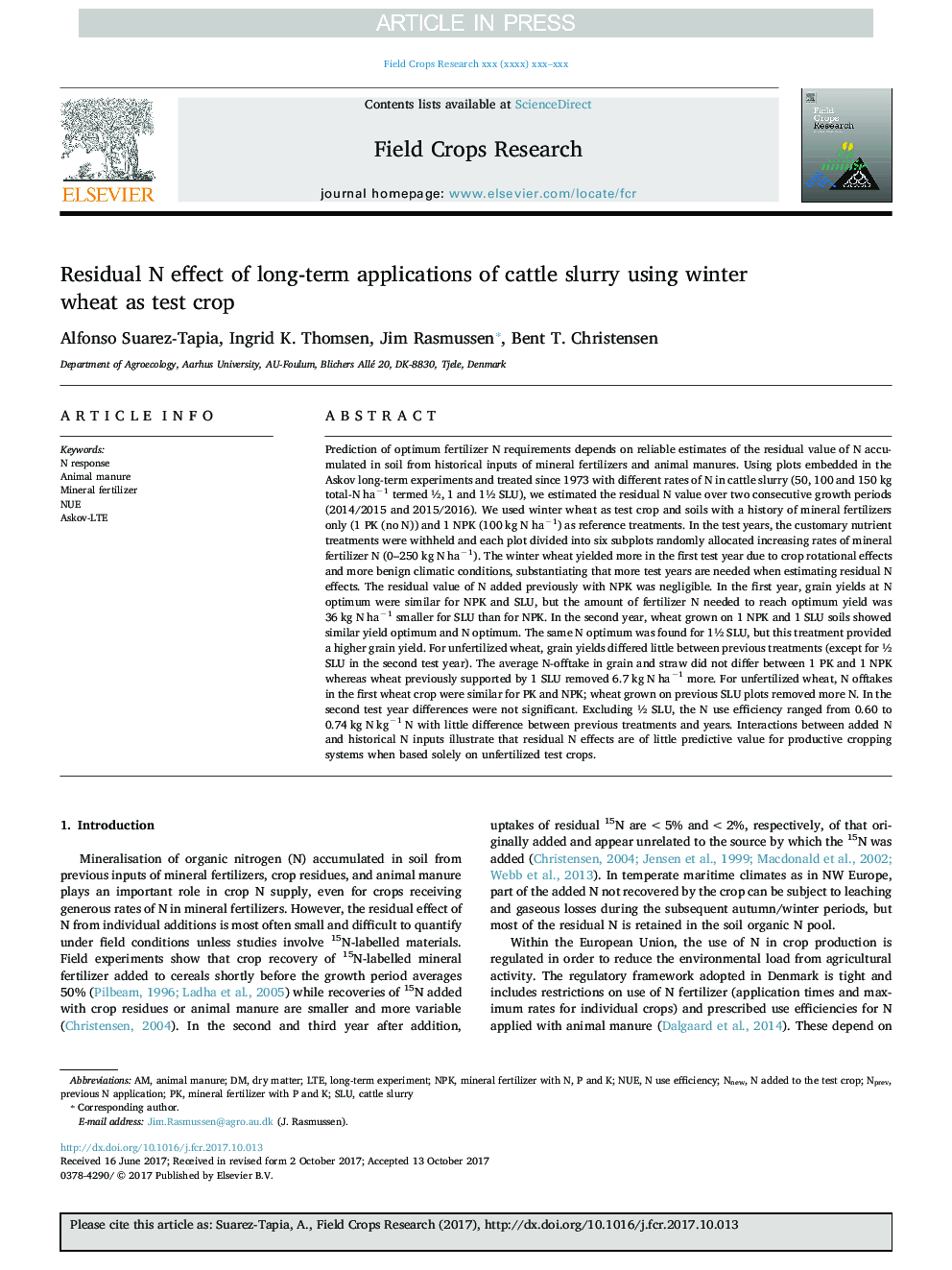| کد مقاله | کد نشریه | سال انتشار | مقاله انگلیسی | نسخه تمام متن |
|---|---|---|---|---|
| 8879266 | 1624642 | 2018 | 8 صفحه PDF | دانلود رایگان |
عنوان انگلیسی مقاله ISI
Residual N effect of long-term applications of cattle slurry using winter wheat as test crop
دانلود مقاله + سفارش ترجمه
دانلود مقاله ISI انگلیسی
رایگان برای ایرانیان
کلمات کلیدی
موضوعات مرتبط
علوم زیستی و بیوفناوری
علوم کشاورزی و بیولوژیک
علوم زراعت و اصلاح نباتات
پیش نمایش صفحه اول مقاله

چکیده انگلیسی
Prediction of optimum fertilizer N requirements depends on reliable estimates of the residual value of N accumulated in soil from historical inputs of mineral fertilizers and animal manures. Using plots embedded in the Askov long-term experiments and treated since 1973 with different rates of N in cattle slurry (50, 100 and 150 kg total-N haâ1 termed ½, 1 and 1½ SLU), we estimated the residual N value over two consecutive growth periods (2014/2015 and 2015/2016). We used winter wheat as test crop and soils with a history of mineral fertilizers only (1 PK (no N)) and 1 NPK (100 kg N haâ1) as reference treatments. In the test years, the customary nutrient treatments were withheld and each plot divided into six subplots randomly allocated increasing rates of mineral fertilizer N (0-250 kg N haâ1). The winter wheat yielded more in the first test year due to crop rotational effects and more benign climatic conditions, substantiating that more test years are needed when estimating residual N effects. The residual value of N added previously with NPK was negligible. In the first year, grain yields at N optimum were similar for NPK and SLU, but the amount of fertilizer N needed to reach optimum yield was 36 kg N haâ1 smaller for SLU than for NPK. In the second year, wheat grown on 1 NPK and 1 SLU soils showed similar yield optimum and N optimum. The same N optimum was found for 1½ SLU, but this treatment provided a higher grain yield. For unfertilized wheat, grain yields differed little between previous treatments (except for ½ SLU in the second test year). The average N-offtake in grain and straw did not differ between 1 PK and 1 NPK whereas wheat previously supported by 1 SLU removed 6.7 kg N haâ1 more. For unfertilized wheat, N offtakes in the first wheat crop were similar for PK and NPK; wheat grown on previous SLU plots removed more N. In the second test year differences were not significant. Excluding ½ SLU, the N use efficiency ranged from 0.60 to 0.74 kg N kgâ1 N with little difference between previous treatments and years. Interactions between added N and historical N inputs illustrate that residual N effects are of little predictive value for productive cropping systems when based solely on unfertilized test crops.
ناشر
Database: Elsevier - ScienceDirect (ساینس دایرکت)
Journal: Field Crops Research - Volume 221, 15 May 2018, Pages 257-264
Journal: Field Crops Research - Volume 221, 15 May 2018, Pages 257-264
نویسندگان
Alfonso Suarez-Tapia, Ingrid K. Thomsen, Jim Rasmussen, Bent T. Christensen,